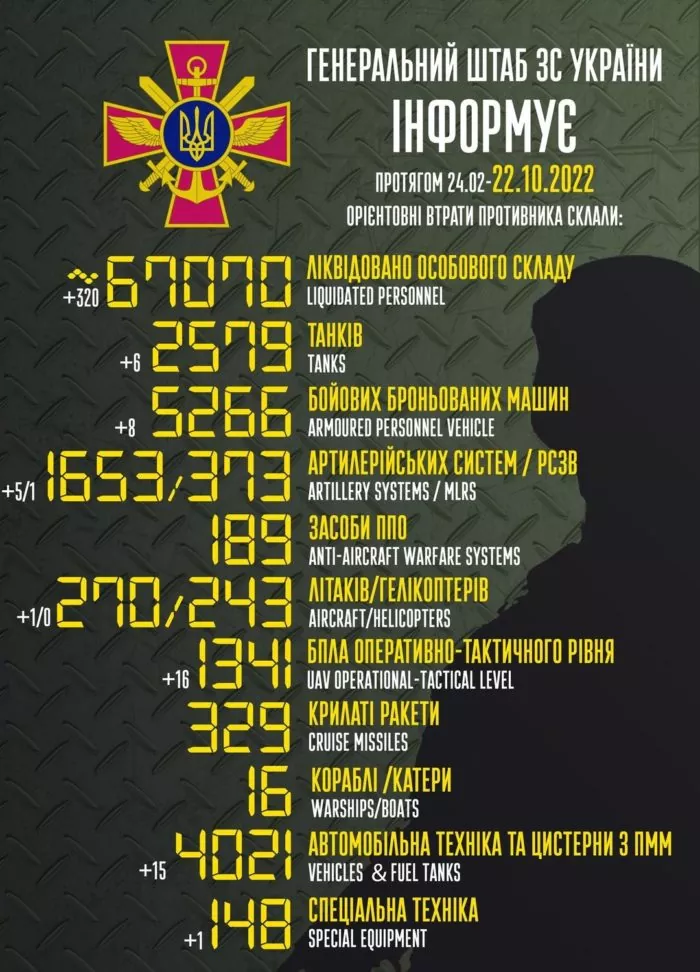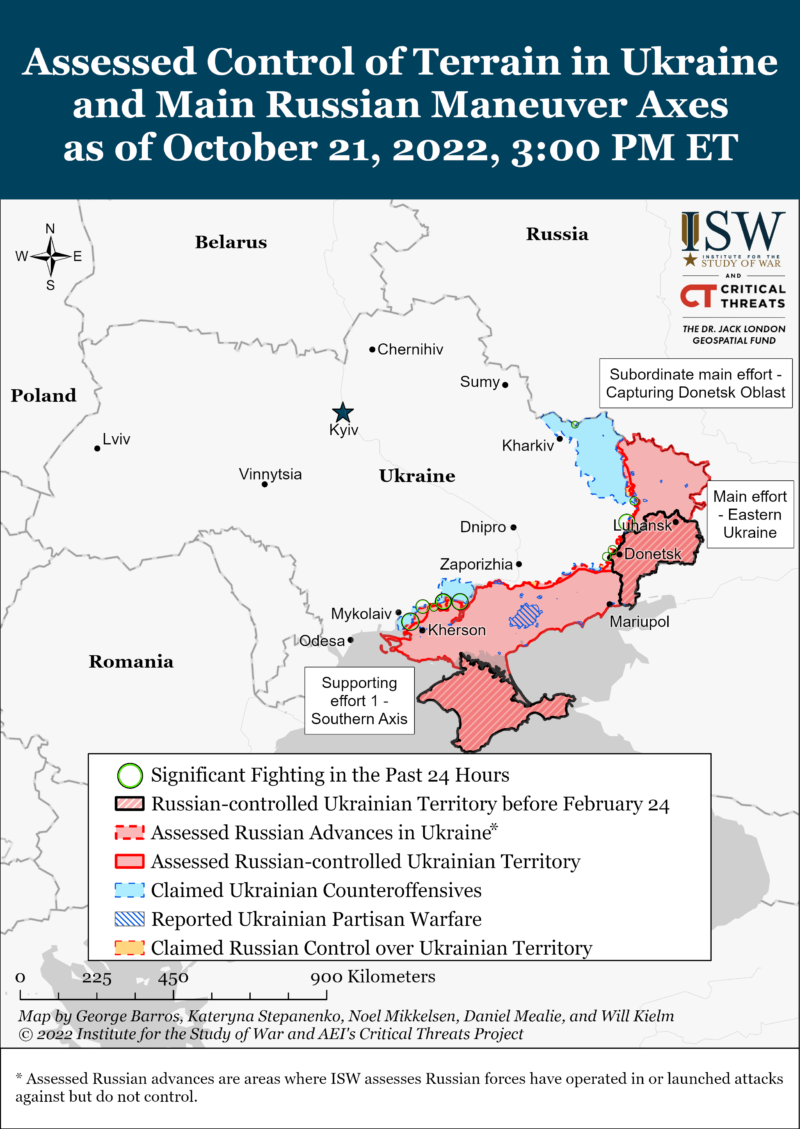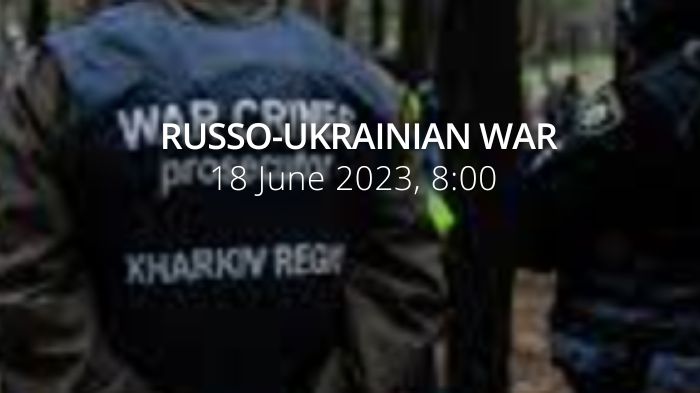Russian forces conducted a massive missile attack on Ukraine's energy infrastructure, continued ground attacks in Donetsk Oblast and routine fire west of Hulyaipole and in Mykolaiv Oblast. Russian withdrawal from western Kherson Oblast has begun. Russian occupation administration claims it leaves Kherson city, says all Khersoners “must immediately leave” too. Russian forces will "likely attempt to blow up the dam" at the Kakhovka power plant to cover their retreat from Kherson City. The Netherlands supported the creation of a special tribunal to investigate Russian crimes committed in Ukraine.
Daily overview — Summary report, October 22
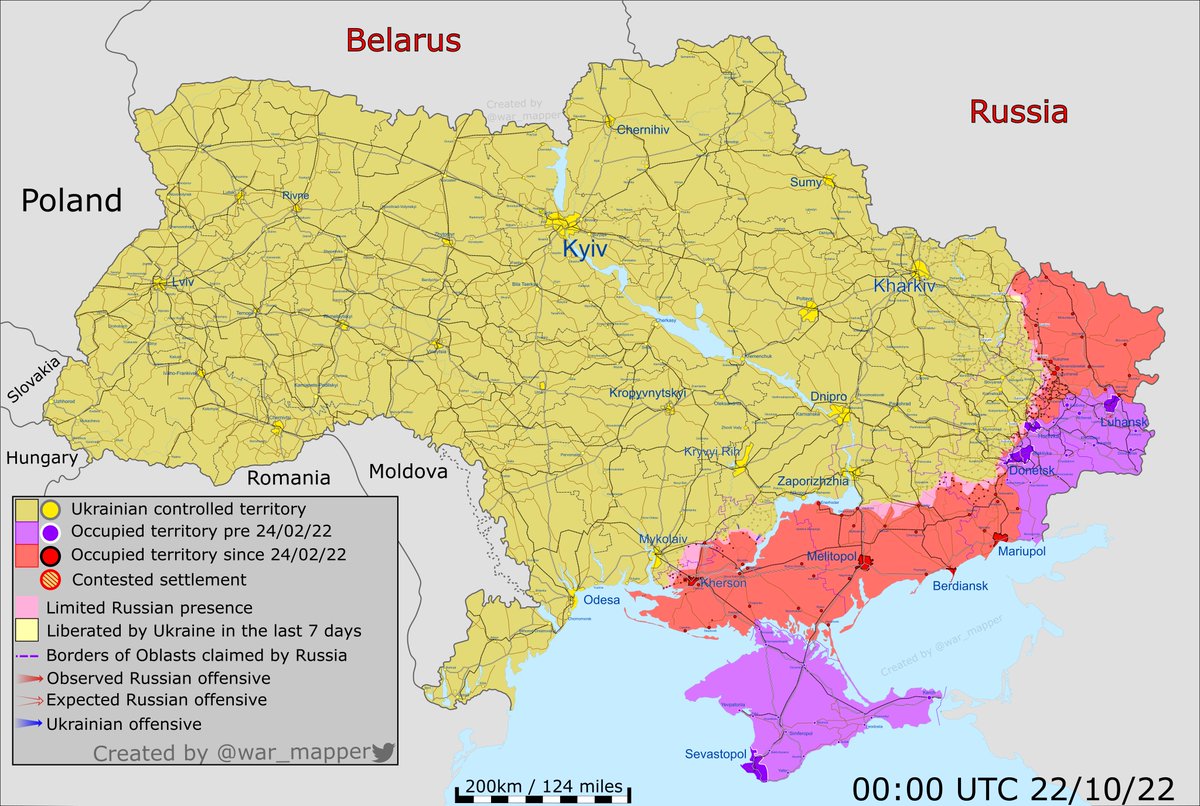
The General Staff’s operational update regarding the Russian invasion as of 06.00 am, October 22, 2022 is in the dropdown menu below
The two-hundred-forty-first (241) day of the heroic resistance of the Ukrainian people to a Russian military large-scale invasion continues.
The enemy is trying to keep the temporarily captured territories, and concentrates efforts on restraining the actions of the Defence Forces in certain directions, at the same time, it does not abandon attempts to conduct offensive actions in the Bakhmut and Avdiivka directions.
Over the past 24 hours, units of the Defence Forces have repelled the attacks of the occupiers in the Ternova settlements of the Kharkiv oblast; Bilohorivka and Zolotarivka in Luhansk oblast and Lyman, Ivanhrad, Soledar, Novokalynove, Ozaryanivka, Odradivka, and Pervomaiske in Donetsk oblast.
The enemy is shelling the positions of our troops along the contact line and conducting aerial reconnaissance. It continues to strike critical infrastructure and civilian homes in violation of International Humanitarian Law, the laws and customs of war.
During the day, the enemy carried out 5 missile and 19 air strikes, launched more than 94 MLRS rockets.
Areas of about 20 settlements were hit by enemy attacks. These are, in particular, Kharkiv, Kupiansk; Bakhmut, Odradivka, Mariinka, Zelenopillya of the Donetsk oblast; Zaporizhzhia, as well as Novovoskresenske in the Kherson oblast.
In committing their crimes, the enemy used aviation and anti-aircraft guided missiles, as well as Shahed-136 attack UAVs.
The situation in the Volyn and Polissya directions has not changed significantly. The deployment of the joint regional grouping of troops of the Russian Federation and the Republic of Belarus continues. During the day, enemy aviation carried out training flights in the airspace of the Republic of Belarus.
According to the available information, there have been not rare cases of conflicts between the Russian and Belarusian military personnel against the background of nationality and the Russians' defiant attitude towards Belarusians.
The enemy shelled in other directions:
- in the Siverskyi direction - from mortars and barrel artillery, from the areas of Ukrainja, Mykolaivka, Krasnyi Khutir, and Hai settlements of Chernihiv oblast, as well as Pokrovka in Sumy oblast;
- in the Slobozhansk direction - from tanks, mortars, barrel and rocket artillery, in the areas of the settlements of Vovchansk, Hatyshche, Hlyboke, Milove, Ohirtseve, Neskuchne, Starytsa, Ternova, Strilecha, and Chuhunivka;
- in the Kupiansk direction - from mortars and rocket artillery, in the areas of the settlements of Kolodyazne, Dvorichna, Bohdanivka, Berestove, and Kyselivka;
- in the Lymansky direction - from tanks, mortars, barrel and jet artillery, in the areas of Karmazynivka, Zarichne, Shyiykivka, and Terny settlements;
- in the Bakhmut direction - from tanks, mortars, barrel and jet artillery, in the areas of Andriyivka, Soledar, Bakhmutske, Bakhmut, Bilohorivka, Verkhnyokamianske, Spirne, Ivangrad, Rozdolivka, Zelenopillya, Klishchiivka and Opytne settlements;
- in the Avdiivka direction - from tanks and artillery, in the areas of Avdiivka, Vesele, Krasnohorivka, Mariinka, Novomykhailivka, Vodyane, and Pervomaiskyi.
The enemy did not conduct active offensives in the Novopavlivskyi and Zaporizhzhia directions. It carried out shelling in the areas of Vuhledar, Prechystivka, Vremivka, Velyka Novosilka, Biloghirya, Zeleny Hay, and Mala Tokmachka.
In the South Buh region, more than 20 settlements near the contact line were damaged by fire. Among them are Novovoskresenske, Myrne, Davidiv Brid and Novohredneve.
According to available information, a large part of the population left the city of Kherson. The Russian occupiers, who remained in the city, change into civilian clothes and move into the abandoned apartments. The enemy is preparing Kherson for street battles.
As of October 21, the Russian occupiers are conducting measures to free the premises of the Kakhovka Hospital from patients and medical personnel.
In the city of Enerhodar, Russian soldiers are looting abandoned apartments and hotels where they lived.
The level of dissatisfaction with the actions of the military leadership on the part of the civilian population of the Russian Federation is increasing. In particular, because of the mobilization that still continues in remote regions, despite the official announcement of its end.
The aviation of the Defence Forces carried out 16 strikes during the past day. The defeat of three strongholds and ten areas of concentration of weapons and military equipment, as well as three positions of the enemy's anti-aircraft missile systems, was confirmed. In addition, our air defense units shot down an enemy Su-25 aircraft and one Orlan-10 UAV in various directions.
Over the past day, soldiers of the missile forces and artillery hit 2 control points, 14 areas of concentration of manpower, weapons, and military equipment, an ammunition warehouse, the enemy's S-300 anti-aircraft missile complex, enemy artillery at firing positions, and 5 more important targets.
Military Updates
- A Russian Ka-52 strike helicopter shot down in Kherson Oblast, and a Russian Su-25 attack aircraft downed in Mykolayiv Oblast
- Ukraine’s air defenses destroy 18 of 33 Russian missiles on the morning of Oct 22, and 10 kamikaze drones at night
https://twitter.com/EuromaidanPress/status/1583804917289869312
- German IRIS-T anti-aircraft missile systems are “very effective but there are few of them,” Air Force of Ukraine says
- Ukraine hits occupied Kherson’s key bridge on next day after Russian officials inspected it
https://twitter.com/EuromaidanPress/status/1583775421904166915
According to British Defence Intelligence, (last 48 hours):
- Russian forces continue to reinforce crossing points over the Dnipro River, and have completed a barge bridge alongside the damaged Antonovskiy bridge in Kherson.
- Although the use of heavy barge bridges was almost certainly included in Soviet-era planning for operations in Europe, it is likely this is the first time the Russian military have needed to utilise this type of bridge for decades.
- Using civilian barges likely provides Russia additional material and logistics benefits, having lost significant quantities of military bridging equipment and engineering personnel during its invasion.
- If the barge bridge sustains damage, it is almost certain Russia will seek to repair or replace damaged sections quickly, as their forces and crossing points over the Dnipro river come under increasing pressure in Kherson.
Losses of the Russian army
As of 22 October, the approximate losses of weapons and military equipment of the Russian Armed Forces from the beginning of the war to the present day:
Humanitarian
- Russian occupation administration claims it leaves Kherson city, says all Khersoners “must immediately leave” too.
- Russian occupation authorities ceased activities in Kherson’s Beryslav – GenStaff
- Ukraine came under a massive Russian missile attack on the morning of Sep 22: Russia keeps targeting energy infrastructure
- Russian occupiers drove 46 children of Kherson Oblast Children’s Home to occupied Simferopol
- Ukraine calls on EU not to grant asylum to Russians fleeing mobilization after fire in German hotel with Ukrainians
- Russian occupiers murdered woman who said that Skadovsk is Ukraine
Yurii Kerpatenko refused to bow to Russian orders - Obituary by The Economist
The conductor from Kherson was probably murdered sometime in September, aged 46https://t.co/2OSDvno3VO pic.twitter.com/pC1pzsfttd
— Euromaidan Press (@EuromaidanPress) October 22, 2022
Environmental
- Russia “will likely attempt to blow up the dam” at Kakhovka to cover its retreat from western Kherson – ISW
- Russia artificially created a queue of 150 vessels as part of the grain initiative – Zelenskyy
- Ukraine’s state company Naftogaz opened a new gas well in Kharkiv Oblast
Legal
- 24 Russian arms producers are still not on Western sanctions lists — report
- Yermak-McFaul Group offers democratic countries a list of Russians to sanction
- Britain, Germany and France called on UN to investigate Iran’s supply of drones to Russia
- Netherlands supported creation of special tribunal to investigate Russian crimes committed in Ukraine
Support
- German company delivers air defense radars for Ukraine “in record time” - one is already in Ukraine, three more will arrive in the upcoming months
Assessment
The Institute for the Study of War has made the following assessment as of 21 October 2022:
- The Russian withdrawal from western Kherson Oblast has begun. Russian forces likely intend to continue that withdrawal over the next several weeks but may struggle to withdraw in good order if Ukrainian forces choose to attack.
- Russian President Vladimir Putin is demonstrably setting conditions for Russia to continue a protracted war in Ukraine, not for a negotiated settlement or offramp.
- Russian forces will likely attempt to blow up the dam at the Kakhovka Hydroelectric Power Plant (HPP) to cover their withdrawal from Kherson City and to prevent Ukrainian forces from pursuing Russian forces deeper into Kherson Oblast.
- Russian President Vladimir Putin signed a decree on October 21 creating a Russian government “coordination council” to improve wartime federal coordination.
- Russian and Ukrainian sources reported fighting northeast of Kharkiv City along the international border, on the Svatove-Kreminna frontline, and west of Lysychansk.
- Ukrainian military officials offered a limited overview of the situation on the frontline.
- Ukraine’s Southern Operational Command emphasized that Russian forces are using Ukrainian civilians as human shields when transporting military equipment across the Dnipro River, while Russian sources released footage showing a line of civilians awaiting the ferry from Kherson City.
- Russian forces continued ground attacks in Donetsk Oblast and routine fire west of Hulyaipole and in Mykolaiv Oblast.
- Russian authorities are attempting to maintain the façade of sustainable and strong logistics in southern Ukraine while accelerating measures to compensate for the Kerch Strait Bridge attack.
- Fissures between regional Russian officials, the Russian Ministry of Defense (MoD) and military commissariats, and the Russian civilian population from which mobilization draws will likely intensify in the coming months.
- Russian authorities are preventing Ukrainians in Russia from leaving Russia with complex residency and permit requirements to cross international borders.
- Russian occupation authorities continued the mass forced removal of civilians from the west bank of the Dnipro River under the guise of civilian “evacuations.”
Eastern Ukraine: (Oskil River-Kreminna Line)
Russian forces attempted an unsuccessful assault northeast of Kharkiv City along the international border and continued to shell settlements along the Oskil River on October 21. The Ukrainian General Staff reported that Ukrainian forces repelled a Russian assault on Ternova, approximately 40km northeast of Kharkiv City. Ukrainian officials and Russian sources reported that Russian forces conducted a missile strike on industrial infrastructure in Kyivsky Raion in Kharkiv City. Russian forces continued to shell and launch airstrikes on Kupiansk and settlements in its vicinity.
Russian and Ukrainian forces continued to fight on the Svatove-Kreminna frontline on October 21. Luhansk Oblast Administration Head Serhiy Haidai stated that the territory near Svatove remained the most active frontline as Russian forces continued to try to regain their lost positions around Svatove. Haidai added that Russian forces concentrated most of their military equipment near Svatove and Troitske (about 55km northeast of Svatove). The Ukrainian General Staff additionally reported that Ukrainian forces repelled a Russian assault on Lyman. Russian sources claimed that Ukrainian forces unsuccessfully attempted to attack in the vicinity of Terny (about 16km northeast of Lyman) and tried to reach the R66 Kreminna-Svatove highway. The Russian Ministry of Defense also claimed that Russian artillery fire prevented Ukrainian forces from crossing the Zherebets River near Novovodyane (about 18km southwest of Svatove) and Torske (approximately 13km east of Lyman).
Russian forces reportedly conducted several unsuccessful assaults west of Lysychansk on October 21. The Ukrainian General Staff reported that Ukrainian forces suppressed Russian attacks on Bilohorivka and Zolotarivka, both just over 10km west of Lysychansk. Russian sources also claimed that Russian forces staged an assault in the vicinity of Bilohorivka to regain positions on the southern bank of the Siverskyi Donets River in the area.
Southern Ukraine: (Kherson Oblast)
Russian forces began their withdrawal from western Kherson Oblast.
Ukrainian military officials offered a limited overview of the situation on the frontline on October 21. The Ukrainian General Staff reported that Russian forces struck Novovoskresenske, Nova Kamianka, and Mala Seideminukha in northern Kherson Oblast. Russian sources in turn claimed that Ukrainian forces withdrew from Nova Kamianka to Ukrainka to reinforce their units, and the Russian Ministry of Defense (MOD) claimed that Russian forces struck a Ukrainian hangar in the settlement. Geolocated footage showed the aftermath of Russian artillery strikes supposedly on Ukrainian efforts to advance south of Nova Kamianka, and some Russian milbloggers claimed that Ukrainian forces attempted to advance in the Beryslav direction. The Russian MoD also claimed that Russian forces prevented Ukrainian counteroffensives in the Davydiv Brid-Sukhyi Stavok area near the Inhulets River. Russian sources claimed that Ukrainian forces continued to shell settlements northwest of Kherson City.
Ukraine’s Southern Operational Command emphasized that Russian forces are using Ukrainian civilians as human shields when transporting military equipment across the Dnipro River, while Russian sources released footage showing a line of civilians awaiting the ferry from Kherson City. Russian forces may be transporting withdrawing military personnel alongside civilians to limit Ukrainian strikes. The use of human shields is a war crime. Ukrainian forces continued their interdiction campaign in Kherson Oblast by striking the Antonivsky Bridge on October 20. Russian sources accused Ukrainian forces of killing four civilians who were reportedly crossing the bridge. Southern Operational Command Spokesperson Nataliya Humenyuk confirmed that Ukrainian forces struck the Antonivsky Bridge in the middle of the night and claimed that the presence of civilians on the bridge is not possible due to a Russian-imposed curfew in Kherson Oblast. The Ukrainian General Staff also confirmed that Ukrainian forces struck a Russian pontoon crossing under the Antonivsky Bridge on October 19. Ukrainian forces otherwise continued to strike Russian positions and ammunition depots in northern and central Kherson Oblast.
Russian Main Effort—Eastern Ukraine
Russian Subordinate Main Effort—Donetsk Oblast (Russian objective: Capture the entirety of Donetsk Oblast, the claimed territory of Russia’s proxies in Donbas)
Russian forces continued ground attacks in Donetsk Oblast on October 21. The Ukrainian General Staff reported that Ukrainian forces repelled Russian ground attacks near Bakhmut, northeast of Bakhmut near Soledar, and south of Bakhmut near Ozaryanivka, Optyne, and Odradivka. A Russian source claimed that Wagner Group fighters advanced from positions on the eastern outskirts of Bakhmut to the center of Bakhmut and that Wagner Group personnel gained fire control over a railway that Ukrainian forces use to supply the Bakhmut area. A Russian source claimed that Russian forces, likely referring to Wagner Group or proxy Donetsk People’s Republic (DNR) forces, seized the last fortified Ukrainian position before reaching Optyne south of Bakhmut. The Ukrainian General Staff also reported that Ukrainian forces repelled Russian ground attacks east of Avdiivka near Pervomaiske and southwest of Donetsk City near Mariinka and Pobieda. A Russian source claimed that Russian forces conducted ground attacks near Marinka and southwest of Avdiivka towards Nevelske. The Russian Ministry of Defense claimed that Russian forces repelled Ukrainian small-group attempts to attack Russian positions near the Vremivka bulge in western Donetsk Oblast. 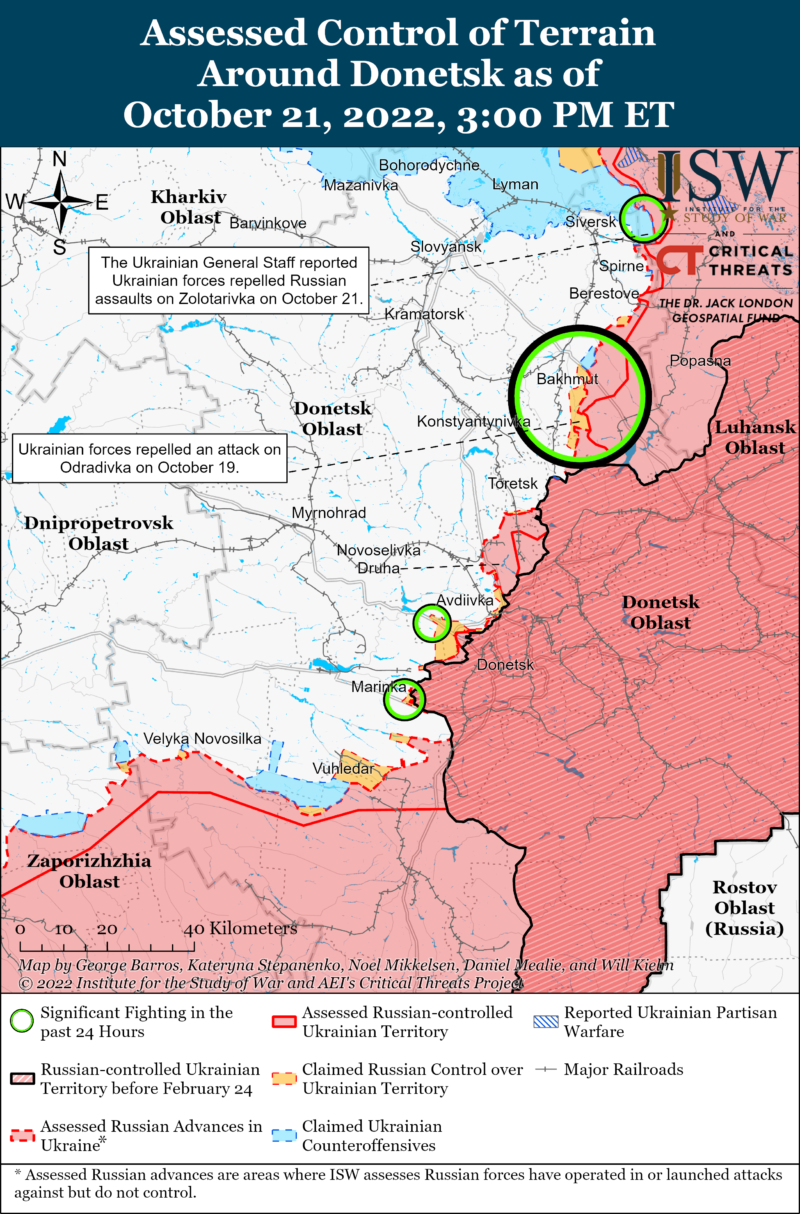
Supporting Effort—Southern Axis (Russian objective: Maintain frontline positions and secure rear areas against Ukrainian strikes)
Russian forces continued routine fire west of Hulyaipole and in Mykolaiv Oblast on October 21. Russian and Ukrainian sources reported that Russian forces struck Zaporizhzhia City, Mykolaiv City, and Kutsurub Hromada in Mykolaiv Oblast. Ukrainian Dnipropetrovsk regional authorities reported that Russian forces did not fire on areas in Dnipropetrovsk Oblast overnight or during the day on October 21, which would be consistent with reports of a withdrawal of Russian combat forces from Enerhodar. Dnipropetrovsk Oblast head Valentyn Reznichenko stated that the night of October 20-21 was the first night without sirens and attacks on the region in three and a half months. Ukraine’s Southern Operational Command acknowledged an anomalous temporary lull in Russian shelling and attacks in southern Ukraine on October 21. Ukrainian sources reported that Ukrainian forces struck Russian military positions in Melitopol, injuring at least 30 and killing at least 30. Ukrainian Nikopol Head Yevhen Yevtushenko stated that the strike injured 40 “bearded men,” likely referring to Chechen forces.
Russian authorities are attempting to maintain the façade of sustainable and strong logistics in southern Ukraine while accelerating measures to compensate for the damage to the Kerch Strait Bridge. Crimean occupation Head Sergey Aksyonov claimed that over 1,000 trucks have traveled to southern Ukraine across alternate land routes and that ferries transported over 720 vehicles across the Kerch Strait on October 19-20, likely to downplay the impact of the Kerch Strait Bridge attack on Russian logistical capabilities. Zaporizhzhia Oblast occupation head Yevgeny Balitsky reported that Russian authorities have begun efforts to restore the Melitopol-Dzhankoi highway that were originally supposed to begin in 2023.
Mobilization and Force Generation Efforts (Russian objective: Expand combat power without conducting general mobilization)
Fissures between regional Russian officials, the Russian Ministry of Defense (MoD) and military commissariats, and the Russian civilian population from which mobilized forces are drawn will likely intensify in the coming months. A prominent Russian milblogger attacked the notion that Russian authorities outside of the MoD’s chain of command have any legal authority over mobilization practices and criticized Moscow Mayor Sergey Sobyanin’s October 17 statement that the mobilization in Moscow City ended because the city reached its mobilization quota. The milblogger stated that regional heads have some liberty to make mobilization decisions pertaining to the implementation of mobilization but have no legal authority to unilaterally announce the start or end of mobilization periods. The milblogger stated that partial mobilization is incomplete, that covert mobilization will continue, and that Russian citizens must accept the uncomfortable fact that military mobilization is necessary to win the war in Ukraine. A Moscow-based lawyer stated that a military enlistment officer beat him up when he presented deferral documents for mobilized men that cited Sobyanin’s statement that mobilization ended on October 17. Moscow officials are likely to continue mobilizing Muscovites despite local officials framing mobilization in Moscow as complete, as ISW previously assessed.
Belarusian officials may be assisting the Kremlin in detaining Russian men fleeing mobilization in Belarus. A Russian Telegram channel reported that Belarusian authorities began preventing Russian men from leaving Belarus starting on October 20 and that Belarusian authorities have detained 10 Russian men who attempted to board international flights departing Belarus as of October 21.
Mobilized Russian prisoners continue their poor battlefield performance. A captured Wagner soldier who was recruited from a Ryazan penal colony stated that three-fourths of his unit died in combat near Bakhmut, and that Russian forces shot his comrades who refused to fight, instructed them to commit suicide rather than face capture, did not pay them, and treated them like cannon fodder. Another mobilized prisoner stated that Russian mobilization officials forced Russian prisoners to mobilize, did not provide Russian prisoners any training, and provided enough food for soldiers to eat only one meal a day.
The Russian military is continuing to struggle to supply Russian forces in Ukraine. A group of mobilized Russian soldiers from Krasnodar Krai operating in an unspecified part of Ukraine released a recorded appeal to Russian authorities on October 21, stating that they have run out of food, water, medicine, and ammunition. Russian-backed Zaporizhzhia Oblast occupation administration official Vladimir Rogov called for donations to buy communications equipment for Russian forces fighting in Zaporizhzhia on October 21.


